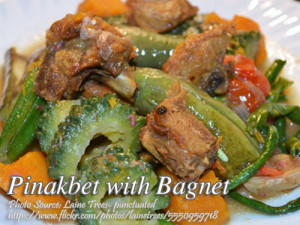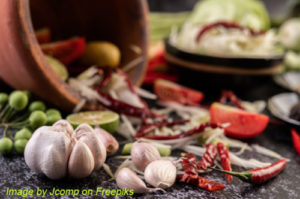This milkfish dish called binagoongang bangus belly is a fish version of the popular binagoongang baboy or binagoongang manok. The dish is quite easy to cook since it requires less time than using pork or chicken. And with regards to buying the shrimp paste or bagoong alamang, it is preferable to buy the fresh one sold usually in wet markets.
The color is usually pinkish and watery. Some bagoong alamang are very salty and sometimes the fishy odor is too strong which indicates that the bagoong is fermented. But the best ones are not too salty and not fermented. And before using the bagoong, it is advisable to wash it in running water while in a fine strainer. It will lessen the saltiness and remove some impurities in the bagoong.
The Flavorful Delight of Binagoongang Bangus Belly
Binagoongang Bangus Belly is a delectable Filipino dish that brings together the succulence of milkfish belly with the rich flavors of shrimp paste, vinegar, and spices. It’s a delightful alternative to the more common pork or chicken versions of binagoongan. In this article, we’ll guide you through the steps to create this savory dish that’s sure to tickle your taste buds.
Choosing the Right Bagoong Alamang
The key to a great Binagoongang Bangus Belly lies in selecting the perfect bagoong alamang, or shrimp paste. This ingredient can greatly influence the overall taste of your dish. When purchasing bagoong alamang, opt for the fresh variety typically found in wet markets. Look for the pinkish and slightly watery type, which is often less salty and less fermented than the stronger-smelling, more potent versions. Fresh bagoong has a milder aroma and flavor that pairs perfectly with the delicate taste of bangus belly.
Preparing the Bagoong Alamang
Before incorporating the bagoong alamang into your Binagoongang Bangus Belly recipe, it’s essential to prepare it properly to ensure that the dish isn’t overly salty. Begin by washing the bagoong under running water while using a fine strainer. This step helps reduce the saltiness and eliminates any impurities that might affect the dish’s taste. Once the bagoong is clean, you’re ready to proceed with cooking.
The Step-by-Step Cooking Process
1. Sautéing the Aromatics
Start by heating some cooking oil in a pan over medium heat. Once the oil is hot, add minced garlic and sauté it until it turns slightly brown. The aromatic fragrance of the garlic will begin to fill your kitchen, signaling the beginning of a delicious culinary adventure.
2. Adding Tomatoes
Next, toss in diced tomatoes and stir them until they become soft and slightly mushy. The tomatoes will impart a subtle sweetness to the dish, balancing the salty and savory notes of the shrimp paste.
3. Introducing the Bagoong Alamang
Now, it’s time to incorporate the star ingredient – the bagoong alamang. Add the prepared shrimp paste to the pan and give it a good stir. The bagoong will bring its unique umami flavor to the mix, setting the foundation for the dish’s distinct taste.
4. A Splash of Vinegar
Pour vinegar into the pan and allow it to simmer for about a minute. Don’t stir immediately; let the vinegar infuse its tangy essence into the bagoong. After a minute, gently stir the mixture to ensure that the flavors blend harmoniously.
5. Low Heat Simmering
Cover the pan and reduce the heat to low. Let the Binagoongang Bangus Belly simmer gently for 10 minutes. Stir occasionally and add more oil if needed to prevent the bagoong from drying out.
6. Sweetening the Pot
To balance out the dish’s complex flavors, sprinkle brown sugar and black pepper into the pan. Stir until the sugar completely dissolves, enhancing the sweetness of the tomatoes and countering the saltiness of the shrimp paste.
7. Adding the Bangus Belly
Carefully place the bangus belly into the pan, ensuring that the belly fat is facing upward. This will allow the belly to absorb the flavors and stay tender during the cooking process. Give it a gentle stir to coat the fish with the savory sauce.
8. Spice it Up (Optional)
For those who crave a bit of heat, add some red chili peppers to your Binagoongang Bangus Belly. These peppers will provide a spicy kick that contrasts beautifully with the dish’s savory and slightly sweet profile.
9. Low and Slow Simmer
Cover the pan once more and continue simmering the dish over very low heat for approximately 30 minutes. This slow-cooking process allows the flavors to meld together and ensures that the bangus belly becomes tender and flavorful.
Serving Your Binagoongang Bangus Belly
Once your Binagoongang Bangus Belly is ready, serve it hot alongside a generous portion of steaming cooked rice. The contrast of flavors and textures in this dish – from the succulent bangus belly to the salty-sweet shrimp paste – is a true Filipino culinary delight.
Binagoongang Bangus Belly offers a unique and flavorful twist on a classic Filipino dish. Choosing the right bagoong alamang and properly preparing it, along with following these step-by-step instructions, will ensure a dish that’s not only delicious but also a crowd-pleaser. So, next time you’re in the mood for something special, give this recipe a try and savor the wonderful tastes of Binagoongang Bangus Belly.
Binagoongang Bangus Belly
Ingredients
- 1 kilo boneless bangus belly (milkfish belly) sliced into serving pieces
- 1 head garlic minced
- 3 pcs ripe tomatoes chopped
- 100 grams fresh bagoong alamang (shrimp paste)
- 3 Tbsp. white vinegar
- 1/4 cup cooking oil
- 1 Tbsp. brown sugar
- 1/2 tsp ground black pepper
- 2 pcs siling labuyo chopped
Instructions
How to Cook Binagoongang Bangus Belly
- Heat cooking oil in a pan and saute garlic until slightly brown.
- Add tomatoes and stir until soft. Add the bagoong alamang and stir.
- Add vinegar and allow to simmer for 1 minute. Do not stir. Then stir for a few seconds.
- Cover and simmer again in low heat for 10 minutes. Stir and add more oil if the bagoong is drying out.
- Add brown sugar and black pepper and stir until the sugar dissolves in the mixture.
- Add the bangus belly and stir for a few seconds. Then arrange the bangus belly in the pan with the belly fat facing up.
- Add some red chili peppers to add some kick or make it spicy.
- Cover and simmer again in a very low heat for 30 minutes. Serve with hot steaming cooked rice.
Notes
Cooking Tips of Binagoongang Bangus Belly:
- Select Fresh and Mild Bagoong Alamang: When making Binagoongang Bangus Belly, choose fresh and mildly fermented bagoong alamang, as it will provide a more balanced and less overpowering flavor to your dish.
- Low and Slow Simmering: Allow the dish to simmer over very low heat for the recommended 30 minutes to ensure the bangus belly becomes tender and absorbs the rich flavors of the sauce.
- Adjust Spice Level: To cater to different taste preferences, control the spiciness by adding or reducing the amount of red chili peppers, ensuring that your Binagoongang Bangus Belly has just the right amount of heat for your liking.
Nutrition Notes:
Calorie and other nutrition information is derived from HappyFolks.Com recipe nutrition calculator. The percent daily value (%DV) is based on a daily 2,000 calorie diet.Nutrition Information:
Amount per Serving:200g, Calories:251kcal, From fat:127, Total fat:14.5g, Saturated Fat:9g, Trans Fat:0g, Cholesterol:106mg, Sodium: 562 Total Carbohydrate: 5g, Dietary Fiber: 1g, Sugars: 3g, Protein: 25g, Vitamin A: 14%, Vitamin C: 15%, Calcium: 8%, Iron: 4%






